TravelWatch Newsletter

Fast breaking travel news and creative tour opportunities for senior travelers
What’s on the Travel News Menu Today?
October – November 2020
Senior travel nature vacations, cruise and barging vacations, volunteer vacations worldwide & much more! Would you like to be notified of each bi-monthly issue as it is launched? Click here to add your email to our TravelWatch newsletter notification list. [See our Privacy Policy]
1. A new Swiss project with 50 imaginative accommodation options across the country allows guests to enjoy the pristine magic of the night sky as never before.
2. We introduce travelers to Portugal’s Alentejo region east and south of Lisbon where cork oak forests, wine making, a rich horse history, and more than 2,000 years of settlement by different cultures influence today’s cuisine and architecture.
3. October 3, 2020 marks the 30th anniversary of the reunification of Germany. We look at what this has meant to communities and citizens and to visitors exploring what used to be “East Germany” in this fascinating country.
4. Focusing on Amsterdam, Paris and New York State, we spotlight two tour operators specializing in the extensive legacy of African slavery and the profound influence of African Americans on the music and literature of France to this day.
5. Travel abroad includes a surprising number of people (known as expats) moving their homes to other countries for a time or permanently. We share some statements and questions that expats find most irritating from their friends and family left behind.
We invite you to check out our Feature Link of the Month and our latest Travel Product Reviews.
Star Gazing in Switzerland
Switzerland’s Million Stars Hotel project consists of about 50 unique accommodation options in all of the country’s language regions. These invite guests to enjoy pristine nature or even a backdrop of city life with a starry canopy in an exclusive experience for two.
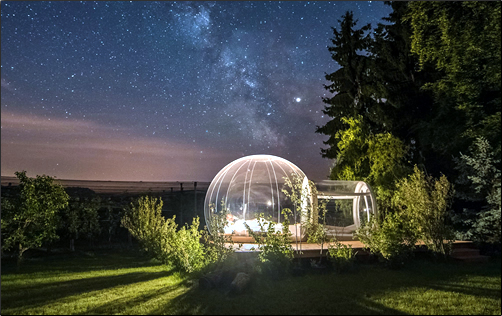
Thurgau Bubble Hotels let you sleep in the most beautiful places, in the middle of Thurgau’s gardens, orchards or vineyards, high above the lake and always under the wide-open sky. The accommodations are placed in quiet and secluded locations around the grounds of the various partner establishments. So you’re assured privacy, despite the transparent walls.
There is a huge diversity of accommodations and locations on offer with an equal diversity of services, but each of the accommodation providers is most often only offering one Million Stars Hotel rooms per property. Most of the locations were created in 2020 especially for the Million Stars Hotel project. Here we have illustrated four accommodations to help explain how this “hotel” (room) looks and feels in reality!
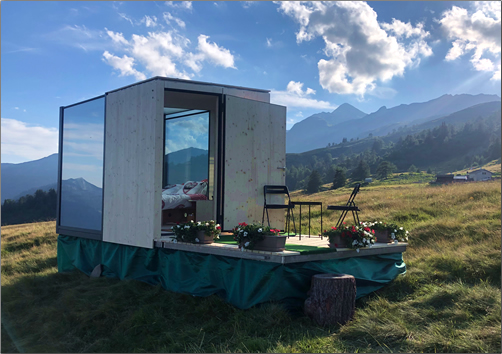
The location of Capanna Gorda is internationally known among astronomy associations for the optimal conditions it offers for stargazing. It lies on a high plateau at an altitude of 1,800 meters/6,000 feet and offers a spectacular view of the Blenio Valley as well as the mighty peaks and surrounding glaciers.
The common denominator for all the rooms is the unimpeded view of the starry sky from your bed: You may choose to sleep outdoors, under a glass roof or behind a large glass façade. The price covers an overnight stay for two people including breakfast. Each accommodation is described in detail on a separate web page and a map is provided to pinpoint the part of Switzerland in which it is situated.
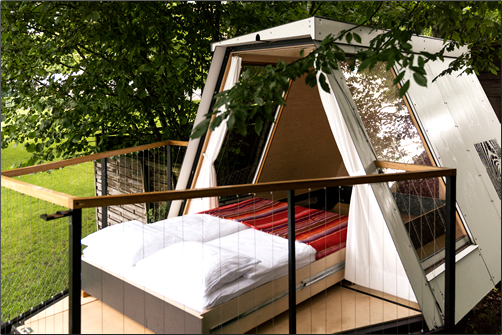
The front of the Lake Glass House can be lowered and used as a balcony – perfect for an aperitif. Once night falls, you can take the bed outdoors and drift off to sleep under the starry night sky against the backdrop of Lake Burgäschi. If it starts to rain in the middle of the night or the sun becomes too warm in the morning, you can simply retreat back into the sheltered house. Guests may eat and drink in the Seeblick Burgäschi restaurant.
Depending on their altitude and “outdoor character”, the Million Stars Hotel rooms are available for bookings from July until the end of October at the latest. Alternative accommodation is available for options that do not offer protection against the elements in case of bad weather. Bathroom facilities can be found nearby (mostly in the hotel, on the farm, etc.).
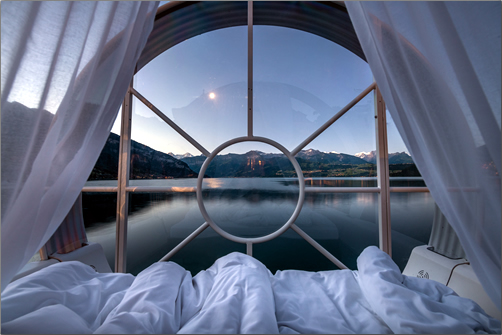 From the comfort of their box spring bed with its open canopy, guests can enjoy the view of the starry sky, Lake Thun, the mighty Niesen peak and the numerous 4,000 meter/13,000 foot peaks of the Bernese Oberland. A generous breakfast is served in Parkhotel Gunten nearby.
From the comfort of their box spring bed with its open canopy, guests can enjoy the view of the starry sky, Lake Thun, the mighty Niesen peak and the numerous 4,000 meter/13,000 foot peaks of the Bernese Oberland. A generous breakfast is served in Parkhotel Gunten nearby.
May Switzerland’s night skies always be clear for guests to enjoy this unique vacation adventure!
Discover Portugal’s Alentejo Region
The Alentejo region, www.visitalentejo.pt/en/, is the heartland of Portugal, stretching from the Tejo River north of Lisbon to the mountains that surround the Algarve in the extreme south, to the border with Spain in the east, and the Atlantic shore in the west. It has inspired countless epic tales and adventures featuring Moors, Romans, Phoenicians and Celts, each leaving their mark on the unique local culture. A land with intense flavors of wine and a local cuisine that is unlike anything else, and as fresh and as local as the land it comes from. A place of plains and mountains, blue rivers, pristine beaches, fortified towns and villages painted in white and blue.

Making up 20% of Portugal, it has just 500,000 inhabitants, living in and around white-washed towns set on green plains, or amid vineyards and olive groves. The Portuguese call the Alentejo, with its own way of speaking, singing and seeing the world, its own nation.

The Alentejo has become Portugal’s new premier wine region. In recent decades, the region’s winemakers have ushered in many of the modern advancements, earning critical acclaim for some full-bodied, fruity reds and light, oaky whites.
The rolling plains are covered with large vineyards, dotted with whitewashed homes and cork trees. Both the wines and cuisine of the Alentejo have been influenced by Greek, Roman and Arab visitors.

Alentejo is also a region with a long horse history, celebrated to this day in colorful festivals and a new Equestrian resort set in 800 hectares/2,000 acres of rolling countryside. Dedicated to the Lusitanian horse breed, the state-owned Royal Horse Farm was founded in 1748. The property now includes the second hotel in Portugal to open under the Revive Program that rehabilitates national historic heritage in the country. Unveiled recently, the Vila Galé Collection Alter Real is a mix of luxury accommodations and guest facilities with equestrian tourism, offering guided farm tours, horse riding, carriage rides and even horse riding lessons for all levels.
The ancient land of Alentejo produces more than half of the world’s total cork from beautiful cork oak forests that are one of the most common tree species in Portugal. They are also a haven for dozens of bird species, butterflies and plants. The process of removal, done once every 9 years, involves removing the outer bark. You can see the stripping of the bark in the Alentejo, and a red tee indicates it has had its bark recently removed. The hardy cork oak then grows a new layer of bark.

The protection of Alentejo’s cork trees by law has resulted in thousands of acres of protected forests and a deep cultural respect for their preservation. Ever since the 17th century, when a certain Benedictine monk, Dom Perignon, selected the bark of the cork oak as the perfect sealant for that legendary champagne, it has been something very special. Today there is enough cork in the forests of Portugal to last more than a century.
Thirtieth Anniversary of German Reunification
On October 3, 2020, all of Germany and the world acknowledges the thirtieth anniversary of German reunification. The peaceful revolution in the German Democratic Republic (GDR), the fall of the Berlin Wall on November 9, 1989, and the opening of the internal borders finally led to the unity of Germany, and to the deep enrichment of tourism exploration that has taken place in the three decades that followed.

With reunification, Berlin was reinstated as Germany’s united capital city. The five states of the former GDR joined the Federal Republic of Germany (formerly West Germany). Extensively restored historic towns and cities became popular travel destinations, as well as places renowned for sustainability, originality, culture, nature, UNESCO sites, art, and art history. According to a study by IPK International’s World Travel Monitor for 2019, Germany became the number one culture destination for Europeans.
In October 2019, I explored for the first time the eastern state of Saxony, saxonytourism.com, bordering the countries of Poland and the Czech Republic. I can highly recommend Saxony for its history, art, and its historical and contemporary architecture to be found in small towns and the splendid larger cities of Dresden and Leipzig. Expect to see monumental Gothic and Renaissance architecture to Baroque to Art Nouveau in the early 20th century and “Neues Bauen” (New Building) or the famous Bauhaus design, conceived in this region 100 years ago to go on to become a worldwide phenomenon. Many buildings include stories of tragic and triumphant human events and even statements of protest.

Especially in Dresden, the capital of Saxony, almost every gorgeous building we see there today is very new but looks very historic. Why? Because this acknowledged center of culture, the arts and power for centuries was literally bombed into rubble a few months before the end of World War II. It was mainly after the reunification of Germany that historic Dresden literally rose from the rubble in a remarkably short couple of decades.
Located on the outer wall of the old city’s Dresden Castle is a fascinating mural (see photo above) made of 23,000 Meissen art tiles depicting 800 years of Saxony rulers and the people they ruled. The massive scale of this 102-meter (335-foot) project initially draws visitors to take photos but it is the intricate detail of the human parade that keeps people studying the scenes for hours. Not surprisingly, here is the largest porcelain artwork in the world, with each tile painted and fired at the must-visit Meissen factory a 30-minute drive away. Completed in 1907, this mural entitled Fürstenzug or Procession of Princes miraculously received only minimal damage during the Dresden bombing 38 years later.
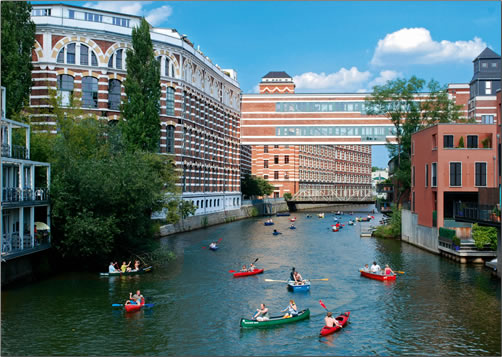
Like its Saxony sister city of Dresden, Leipzig was repeatedly bombed between 1943 and 1945 with great devastation to its cultural and architectural heart. It too has risen from the rubble to become a charming artistic destination reborn, and one of Germany’s greenest cities crossed by numerous rivers and canals. An intriguing design attribute from the Communist era is its repurposed industrial architecture seen along canal waterfronts where boat tours are now offered. The conversion of continental Europe’s largest cotton spinning mill into an enormous, multi-story rabbit warren of artists, workshops and galleries has also given birth to the Spinnerei Art Center and the hot-selling New Leipzig School of Art. None of the rawness of the structure’s earlier life is hidden from visitors.
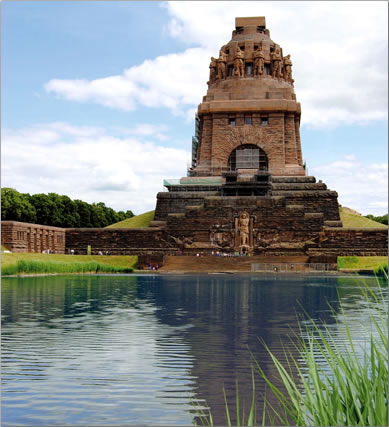
The Monument to the Battle of the Nations near Leipzig commemorates the defeat in 1813 of Napoleon Bonaparte’s forces by a country coalition of Russia, Prussia, Sweden and Austria. Paid for mostly by donations and the city of Leipzig, the monument was completed in 1913 for the 100th anniversary of the battle. I am seldom smitten by 91-meter/299-foot-high monoliths of concrete faced with granite, but this fine example of Wilhelmine architecture was powerful from a distance and filled with stunning sculptures inside. The monument stands on the spot of some of the bloodiest fighting, from which Napoleon ordered the retreat of his army. This is war art at its finest.
Your trip to reunified Saxony will be one highlight after another!
Food for Thought on the Future of Travel“We believe that every traveler is a steward of the world. And that being a good traveler means being a good guest. Before this pandemic, the biggest threat to travel was overtourism—too many people going to the same place, at the same time, to take the same picture, to share with the same group of people. That feels like a lifetime ago, right? I have a suggestion: Let’s not go back to that reality.” AFAR editor in chief Julia Cosgrove.
With those admirable thoughts in mind, let’s also consider what Prince Harry, Duke of Sussex, means by his new travel buzzword, “Regenerative Travel”.
“The global pandemic has brought the world to a standstill and, in the process, destinations and communities who rely on travel and tourism for their livelihoods are facing a challenging and uncertain reality,” the Duke said during a virtual global summit in July hosted by Travalyst — his global tourism initiative launched in September 2019. “Meanwhile, we must remember that the growth of tourism was on an unsustainable trajectory,” he added. “As the travel and tourism industry begins to recover, we want to learn from those who are keeping communities and sustainability at the heart of what they are doing to build back better.”
Black Heritage Tours Tell Different Stories
Black Paris travel expert, Julia Browne, founded Walking The Spirit Tours in 1994, (www.walkthespirit.com), and has pioneered the genre of Black heritage tourism in Paris and other regions of France. With no known Black heritage in my own family tree, I joined one of Julia’s walking tour of Paris a few years ago that followed in the footsteps of transplanted African American intellectuals, artists and musicians in the early 20th century. Their influences were enormous in the European scene reflected to this day, even while they were dismissed as insignificant in their own country.

Julia Browne is a Canadian travel professional, consultant, and lecturer who lived in Paris for more than a decade. Her tours and customized itineraries become trip highlights for individuals and educational institutions exploring heritage ties across Europe, in Canada and Washington DC. Julia is associate producer of the compelling documentary “Paris Noir-African Americans in the City of Light”. Also enjoy reading the fascinating article about Julia’s Paris tours in our Travel Article Library collection.

Recently, I have learned about the Black Heritage Tours company (blackheritagetours.com) founded by Jennifer Tosch, a Surinamese-American who in 2013 launched her highly praised black heritage tours of Amsterdam drawing on the colonial past of The Netherlands. In 2016 she also created a two-day immersive experience exploring New York State (formerly the Dutch colony of New Netherland) through the lens of African slave legacies. Similar interpretive tours in Brussels, Belgium will be launched soon by Jennifer with what I am sure will be the same passion as she brings to her Amsterdam and New York tours.

Indeed Jennifer is a lively scholar on the influential period of the Dutch colonial history from the early 1600s onward. “We can’t talk about the origins of the colonial period in North America,” she says, “or any of the territories colonized by Europe without understanding how enslavement of African people influenced its development.”

What you should never say to an expat
Instead of just traveling abroad, maybe you have a reason to work in another country or even retire to another country. This is no small decision, but it is not an uncommon one, as illustrated by the formation of Internations in 2007, now the largest global expat network with four million members in 420 cities worldwide. Their members have offered thoughts on what you should avoid saying if chatting with an expat (short for a person living abroad) and just what the response might be from that expat.

“You’re so lucky”
Yes, we understand that we’re in a sunnier country with friendlier people and better job opportunities but reiterating how ‘lucky’ we are implies that courage, hard work and tenacity played no part. If you want to live where we live, you can but you choose not to.
That’s not because you’re unlucky; it’s a choice you have made, just like my new country is a choice I’ve made.
“Are you fluent yet?”
Seriously, do you know how long it takes to master a language to fluency?
So many of us spend hours every day on our new language and it’s frustrating enough when, after a year, we’re not even at Kindergarten level. Asking if we’re fluent yet makes us feel embarrassed and inferior so please don’t do it!
“Please, it can’t be that bad”
If I’m complaining about how frustrating it is to open a new bank account when I don’t yet have a permanent address, please don’t say “It can’t be that bad! You live by the beach!” or “You have year-round sunshine! Try queuing up for the [bank] in the pouring rain!”
Just because I’ve moved, it doesn’t mean all my problems have melted away. My new country might have better weather, but that doesn’t automatically negate all my problems.
“Not that it matters to you”
I’m in a new country which I call home, yes, but that doesn’t mean I’m not interested or concerned about the state of affairs in my old home.
In the run up to the UK General Election 2015, I was told more than once that it doesn’t concern me because I’ve been in Australia for two years. I still care about [health care], our education system and all the things that make Britain, Britain. It matters to me. Please don’t tell me it doesn’t.
“You should try making friends with more locals”
Okay, I know that I have more English speaking friends than not, but they’re easier to connect with – for now. Until I learn the local language to an advanced level, there’s only so much conversation I can have with locals.
English is the language I think in, cry in, and sometimes I just need people that are effortless to be with. Local friends will come with time, I promise.
“When are you moving back home?”
You think I packed up 20 tonnes of luggage and hauled it across the Atlantic for fun? No. My new country is my new home. Maybe I’ll ‘move back home’ one day but I don’t know that for sure. For now, I’m making a go of things in my new country. Please support me instead of acting like it’s a phase.
Read the original article on Atlas & Boots. Copyright 2015.

On this theme, we recommend two feature articles by expats in our own Travel Article Library : one about retiring from Seattle, Washington to Greece’s southern peninsula to buy an olive grove and learn to grow olives successfully, and another article about retiring from Cleveland, Ohio to Seville, Spain to immerse in the local culture and travel the countries of Europe with ease. Sixteen years later and a book about how to enjoy moving abroad, there are no regrets for our nouveau-Sevillians!
